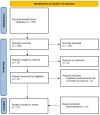Measurement Methods of Fatigue, Sleepiness, and Sleep Behaviour Aboard Ships: A Systematic Review
- PMID: 35010383
- PMCID: PMC8750891
- DOI: 10.3390/ijerph19010120
Measurement Methods of Fatigue, Sleepiness, and Sleep Behaviour Aboard Ships: A Systematic Review
Abstract
Since seafarers are known to be exposed to numerous job-related stress factors that can cause fatigue, sleepiness, and disturbed sleep behaviour, the aim of this review was to provide an overview of the subjective and objective measurement methods of these strains. Using a systematic review, 166 studies were identified within the period of January 2010 to December 2020 using the PubMed database. Of the 21 studies selected, 13 used both subjective and objective measurement methods. Six studies used only subjective and two studies only objective methods. For subjective assessment, 12 different questionnaires could be identified as well as activity and sleeping logs. Actigraphy and reaction time tests (RTT) were the most common objective methods. In single cases, electrooculography (EOG), pupillometry and ambulatory polysomnography (PSG) were used. Measurement-related limitations due to vessel-related impacts were less often reported than expected. No restrictions of daily routines on board were described, and only single-measurement disturbances due to ship movements were mentioned. The present literature review reveals that there are various routines to measure fatigue, sleepiness, and sleep behaviour on board. A combination of subjective and objective methods often appears to be beneficial. The frequent use of actigraphy and RTT on board suggests good feasibility and reliable measurements with these methods. The use of ambulatory PSG in maritime-like contexts suggests that this method would also be feasible on board.
Keywords: actigraphy; fatigue; measurement method; polysomnography; pupillometry; seafaring; sleep; sleepiness.
Conflict of interest statement
The authors declare no conflict of interest. The funders had no role in the design of the study, in the collection, analyses, or interpretation of data, in the writing of the manuscript or in the decision to publish the results.
Figures
Similar articles
-
Systematic review of maritime field studies about stress and strain in seafaring.Int Arch Occup Environ Health. 2013 Jan;86(1):1-15. doi: 10.1007/s00420-012-0801-5. Epub 2012 Aug 23. Int Arch Occup Environ Health. 2013. PMID: 22915144 Review.
-
Sleep and sleepiness of fishermen on rotating schedules.Chronobiol Int. 2008 Apr;25(2):389-98. doi: 10.1080/07420520802106728. Chronobiol Int. 2008. PMID: 18533331
-
Fatigue at sea in Swedish shipping-a field study.Am J Ind Med. 2010 Jul;53(7):733-40. doi: 10.1002/ajim.20814. Am J Ind Med. 2010. PMID: 20187001
-
Sleep, sleepiness, and neurobehavioral performance while on watch in a simulated 4 hours on/8 hours off maritime watch system.Chronobiol Int. 2013 Nov;30(9):1108-15. doi: 10.3109/07420528.2013.800874. Epub 2013 Jul 23. Chronobiol Int. 2013. PMID: 23879695
-
A systematic review of the sleep, sleepiness, and performance implications of limited wake shift work schedules.Scand J Work Environ Health. 2015 Sep 1;41(5):425-40. doi: 10.5271/sjweh.3509. Epub 2015 Jun 23. Scand J Work Environ Health. 2015. PMID: 26103467 Review.
Cited by
-
A rapid, non-invasive method for fatigue detection based on voice information.Front Cell Dev Biol. 2022 Sep 13;10:994001. doi: 10.3389/fcell.2022.994001. eCollection 2022. Front Cell Dev Biol. 2022. PMID: 36176279 Free PMC article.
-
Pupillometry as a new window to player fatigue? A glimpse inside the eyes of a Euro Cup Women's Basketball team.Biol Sport. 2024 Jan;41(1):3-15. doi: 10.5114/biolsport.2024.125590. Epub 2023 May 25. Biol Sport. 2024. PMID: 38188113 Free PMC article.
-
Sleep Architecture and Sleep-Related Breathing Disorders of Seafarers on Board Merchant Ships: A Polysomnographic Pilot Field Study on the High Seas.Int J Environ Res Public Health. 2023 Feb 10;20(4):3168. doi: 10.3390/ijerph20043168. Int J Environ Res Public Health. 2023. PMID: 36833863 Free PMC article.
-
Burnout: A Review of Theory and Measurement.Int J Environ Res Public Health. 2022 Feb 4;19(3):1780. doi: 10.3390/ijerph19031780. Int J Environ Res Public Health. 2022. PMID: 35162802 Free PMC article. Review.
-
Longitudinal Study on the Effect of Onboard Service on Seafarers' Health Statuses.Int J Environ Res Public Health. 2023 Mar 3;20(5):4497. doi: 10.3390/ijerph20054497. Int J Environ Res Public Health. 2023. PMID: 36901506 Free PMC article.
References
-
- IMO Guidelines on Fatigue. [(accessed on 23 April 2021)]. Available online: https://www.imo.org/en/OurWork/HumanElement/Pages/Fatigue.aspx.
-
- Phillips R. Sleep, watchkeeping and accidents: A content analysis of incident at sea reports. Transp. Res. Part F Traffic Psychol. Behav. 2000;3:229–240. doi: 10.1016/S1369-8478(01)00007-9. - DOI
Publication types
MeSH terms
LinkOut - more resources
Full Text Sources


